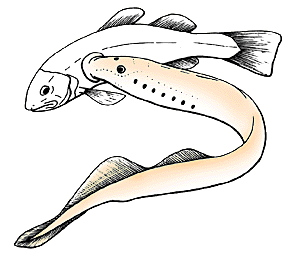anaspid
Any member of an extinct order, Anaspida, of small, freshwater jawless fish of the Silurian and Devonian periods, characterized by a single nostril, narrow rows of scales, and, usually, an armor-plated head.
aspidate
Shaped like a shield; shield-shaped.
aspidistra
A common houseplant of the lily family with large glossy leaves. Flowers: small, brownish. Native to: Asia. Genus Aspidistra, early 19th century from modern Latin which came from Greek aspid-, stem of aspis "shield"; because of the shape of the leaves.
aspidium
The rhizomes and stipes of Dryopteris filix-mus (European aspidium or male fern), or of Dryopteris marginalis (American aspidium or marginal fern) (family Polypodiaceae); used in the treatment of tapeworm infestation, usually in the form of the oleoresin or extract, but because of its potential toxicity, its use is restricted to patients who do not respond to treatment with safer drugs such as dichlorophen, niclosamide, or quinacrine.
aspidomancy
(s) (noun) (no pl)
Divination with a shield by sitting on it within a magic circle and going into a trance; predictions from the devil: In the East Indies,
aspidomancy is a type of ritual magic whereby the psychic draws a circle, sits in the middle, mutters incantations, falls into a trance state, and when back in a normal state knows the answers to the questions of the supplicants.
Another explanation states that it was a primitive form of divination in which an entranced sorcerer, seated in a magic circle, became inspired by the devil and upon awakening recounted the predictions revealed to him from that source.
aspis
The generic term for the word shield.
A hoplon (Greek infantryman) shield was a deeply-dished shield made of wood. Often, particularly later on, it was covered in a thin layer of bronze. In some periods, it was the practice to decorate the aspis; in others, it was left plain. Probably the most famous aspis decoration is that of the Spartans: a red capital lambda (Λ). Hoplites of Athens commonly used the Little Owl, and Thebes used a sphinx.
Cephalaspidea
Bubble shell; order of marine opisthobranch molluscs most of which are bottom-living carnivores, preying on other invertebrates; typically with an external shell, a broad creeping foot and a flatttened dorsal head shield used for burrowing; the stomach has grinding gizzard plates.
Cephalaspidiformes
An extinct order of fish-like vertebrates known from the Silurian and Devonian; body flattened, head broad; ten pairs of ventral gill openings present; mouth ventral and lacking jaws.
Cephalaspidomorphi
Lampreys, hagfish; a class of agnathan vertebrates lacking true gill-arch jaws; contains two extant orders, Petromyzoniformes, Myxinformes, and the fossil Cephalaspidiformes.
A lamprey is a jawless fish with teeth in a funnel-like sucking mouth, which most species use to bore into the flesh of other fishes to suck their blood. In zoology, lampreys are not considered as true fish because of their vastly different morphology and physiology.
Some modern lampreys are external parasites of other fish and suck their blood by attaching to their prey by means of a large sucker surrounding their mouth. Lampreys have a single, median and dorsal "nostril", the nasohypophysial opening, which is situated anteriorly to the eyes.

pteraspid
Extinct jawless fish abundant in lower Devonian times. Pteraspids has massive plated head shields, which could be almost as long as the rest of the body; scaly tails; and only one fin; the tail, or caudal, fin. They are belived to have lived at the bottom of shallow seas, scooping up small invertebrates with their mouth plates.
taxaspidean
Having the posterior tarsal scales, or scutella, rectangular and arranged in regular rows; said of certain birds.

